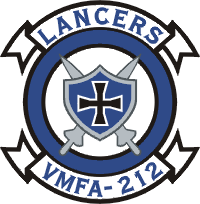
Marine Fighter Attack Squadron 212 (VMFA-212) was a United States Marine Corps F/A-18 Hornet squadron. Most recently known as the "Lancers", the squadron was last based at Marine Corps Air Station Iwakuni, Japan and fell under the command of Marine Aircraft Group 12 (MAG-12) and the 1st Marine Aircraft Wing. VMFA-212 has an extensive combat history having participated in combat operations during World War II, the Korean War, Vietnam War, the Gulf War, and Operation Enduring Freedom. Due to a re-organization within Marine aviation, the squadron was deactivated in 2008.

Marine Fighter Attack Squadron 311 (VMFA-311) is a United States Marine Corps fighter attack squadron consisting of F-35C Lightning II. Known as the "Tomcats", the squadron is based at Marine Corps Air Station Miramar, California and falls under the command of Marine Aircraft Group 11 (MAG-11) and the 3rd Marine Aircraft Wing.

Marine All Weather Fighter Attack Squadron 224 is a United States Marine Corps (USMC) F/A-18 Hornet squadron. Also known as the "Fighting Bengals", the squadron is based at Marine Corps Air Station Beaufort, South Carolina and falls under the command of Marine Aircraft Group 31 (MAG-31) and the 2nd Marine Aircraft Wing. The Bengals are the only Marine F/A-18D Hornet Squadron currently operating out of MCAS Beaufort.

Marine Fighter Attack Squadron 533 (VMFA-533) is a United States Marine Corps F-35B squadron. Also known as the "Hawks", the squadron is based at Marine Corps Air Station Beaufort, South Carolina and falls under the command of Marine Aircraft Group 31 (MAG-31) and the 2nd Marine Aircraft Wing.

Marine Fighting Squadron 111 (VMF-111) was a reserve fighter squadron in the United States Marine Corps. Nicknamed the "Devil Dogs", the squadron was one of the first aviation squadrons in the Marine Corps and gained national attention in the 1930s as the Marine Corps show unit. The squadron fought in World War II and was later transferred to the Reserves where they fell under the command of Marine Aircraft Group 41 (MAG-41) and the 4th Marine Aircraft Wing while stationed at Naval Air Station Dallas, Texas. They were decommissioned on 22 October 1965.

USS Yakutat (AVP-32) was a United States Navy Barnegat-class small seaplane tender in commission from 1944 to 1946. Yakutat tended seaplanes in combat areas in the Pacific during the latter stages of World War II. After the war, she was in commission in the United States Coast Guard from 1948 to 1971 as the Coast Guard cutter USCGC Yakutat (WAVP-380), later WHEC-380, seeing service in the Vietnam War during her Coast Guard career. Transferred to South Vietnam in 1971, she was commissioned into the Republic of Vietnam Navy as the frigate RVNS Trần Nhật Duật (HQ-03). When South Vietnam collapsed in 1975 at the end of the Vietnam War, she fled to the Philippines, where the Philippine Navy took custody of her and cannibalized her for spare parts until discarding her in 1982.

Marine Fighting Squadron 222 (VMF-222) was a fighter squadron of the United States Marine Corps that was activated and fought during World War II. Known as "The Flying Deuces," they fell under the command of Marine Aircraft Group 14 (MAG-14) and fought in many areas of the Pacific War, including the Philippines campaign (1944–45) and the Battle of Okinawa. During the war, the squadron was credited with shooting down 53 enemy aircraft and was the sister squadron to VMF-215. They were deactivated on 31 December 1949.
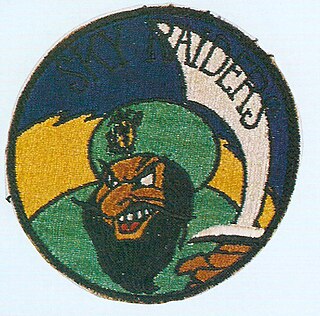
Marine Fighting Squadron 452 (VMF-452) was a fighter squadron of the United States Marine Corps that was commissioned and fought during World War II. Known as the "Sky Raiders", they flew the F4U Corsair, and the Grumman TBF Avenger, fell under the command of Marine Carrier Group 5 (MCVG-5) and fought in the Battle of Okinawa. The squadron is best known for being aboard the USS Franklin (CV-13) when she was severely damaged by Japanese kamikaze planes of the coast of Okinawa on 19 March 1945. VMF-452 was deactivated on 31 December 1949 and has remained in an inactive status since.
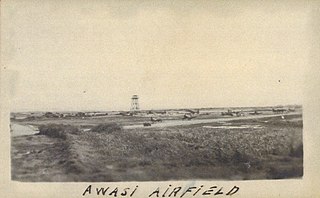
Awase Airfield or NAB Awase is a former World War II airfield on the Pacific coast of Okinawa.

Turtle Bay Airfield or Fighter Field #1 is a former World War II airfield on the island of Espiritu Santo in the New Hebrides Islands at the Espiritu Santo Naval Base.
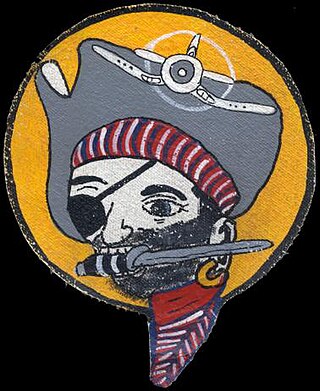
Marine Fighting Squadron 512 (VMF-512) was a fighter squadron of the United States Marine Corps during World War II. The squadron was aircraft carrier based during the last year of the war and supported combat operations during the Battle of Okinawa and the Battle of Balikpapan (1945). Following the end of World War II they were deactivated on 10 March 1946 and remain in an inactive status today.

Ulithi Civil Airfield is a public airport serving the island of Falalop, located in the Ulithi Atoll in the Caroline Islands, Federated States of Micronesia. It was previously Falalop Airfield or Naval Air Base Ulithi, when used as a World War II airfield.
VP-48 was a Patrol Squadron of the U.S. Navy. It was established as VP-208 on 15 December 1942, redesignated Patrol Bombing Squadron VPB-208 on 1 October 1944, redesignated VP-208 on 15 May 1946, redesignated Medium Patrol Squadron (Seaplane) VP-MS-8 on 15 November 1946, redesignated VP-48 on 1 September 1948 and disestablished on 31 December 1949. It was the first squadron to be assigned the VP-48 designation. A second VP-48 was established in May 1946 and disestablished on 23 May 1991.
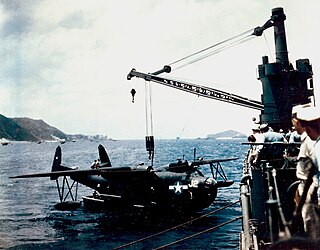
VP-26 was a Patrol Squadron of the U.S. Navy. The squadron was established as Patrol Squadron 26 (VP-26) on 1 May 1944, redesignated Patrol Bombing Squadron 26 (VPB-26) on 1 October 1944, redesignated Patrol Squadron 26 (VP-26) on 15 May 1946 and disestablished on 14 December 1946. It was the second squadron to be designated VP-26, the first VP-26 was redesignated VP-14 on 1 July 1941.
VP-41 was a Patrol Squadron of the U.S. Navy. The squadron was established as Patrol Squadron 21 (VP-21) on 1 March 1944, redesignated Patrol Bombing Squadron 21 (VPB-21) on 1 October 1944, redesignated Patrol Squadron 21 (VP-21) on 15 May 1946, redesignated Medium Patrol Squadron (Seaplane) 11 (VP-MS-11) on 15 November 1946, redesignated Patrol Squadron 41 (VP-41) on 1 September 1948 and disestablished on 23 April 1949.

VP-42 was a Patrol Squadron of the U.S. Navy. The squadron was established as Patrol Squadron 22 (VP-22) on 7 April 1944, redesignated Patrol Bombing Squadron 22 (VPB-22) on 1 October 1944, redesignated Patrol Squadron 22 (VP-22) on 15 May 1946, redesignated Medium Patrol Squadron (Seaplane) 2 (VP-MS-2) on 15 November 1946, redesignated Patrol Squadron 42 (VP-42) on 1 September 1948 and disestablished on 26 September 1969.
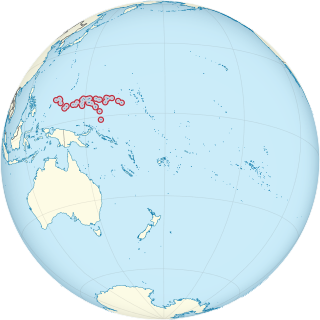
Naval Base Ulithi was a major United States Navy base at the Ulithi Atoll in the Caroline Islands in the western Pacific Ocean, to the north of New Guinea during World War II. The base was built to support the island-hopping Pacific War efforts of the Allied nations fighting the Empire of Japan. In terms of the number of ships at one base, Naval Base Ulithi was the largest naval base in the world in 1944 and 1945, with over 600 ships at times.
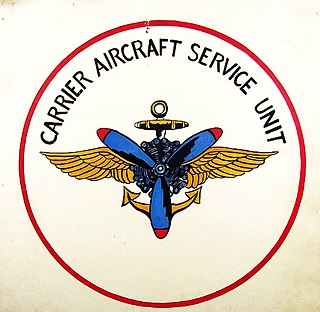
Carrier Aircraft Service Units (CASU) were United States Navy units formed during World War II for the Pacific War to support naval aircraft operations. From 1942 to 1946, 69 Carrier Aircraft Service Units were formed to repair and maintain aircraft. The first unit was deployed to Naval Station Pearl Harbor. The CASU-11, was deployed on January 22, 1943 at Naval Air Station San Diego. During the war the Navy lacked enough aircraft carriers to complete all the operational requirements.
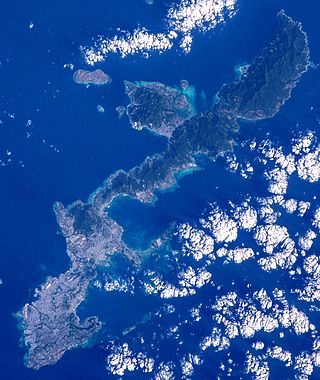
Naval Base Okinawa, now Naval Facility Okinawa, is a number of bases built after the Battle of Okinawa by United States Navy on Okinawa Island, Japan. The naval bases were built to support the landings on Okinawa on April 1, 1945, and the troops fighting on Okinawa. The Navy repaired and did expansion of the airfields on Okinawa. United States Navy Seabees built or repaired the facilities on the island. The bases on Okinawa put the United States Armed Forces only 350 miles from Japan's home islands. Most facilities closed after the war, but some are still in use today by all branches of the United States Armed Forces.


















